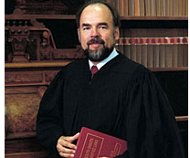Article from: www.thenewspaper.com/news/40/4001.asp
1/16/2013
South Dakota Supreme Court Upholds High Beam Traffic Stop
Cops can continue a traffic stop even after a minor, initial violation is cleared up, South Dakota Supreme Court rules.
 Driving with overly bright headlights justifies a traffic stop, according to a ruling handed down last week by South Dakota's highest court. The court considered the issue in the context of whether a police officer can continue to pursue a traffic stop after realizing he was mistaken about the initial violation he observed.
Driving with overly bright headlights justifies a traffic stop, according to a ruling handed down last week by South Dakota's highest court. The court considered the issue in the context of whether a police officer can continue to pursue a traffic stop after realizing he was mistaken about the initial violation he observed.
South Dakota Highway Patrol Trooper Isaac Kurtz saw the vehicle being driven by Andrew J. Bonacker driving with bright lights in Sioux Falls on April 3, 2010 at about 1am. Trooper Kurtz believed the car's high-beams were active, so he decided to pull the car over for the driver's apparent failure to dim the lights for oncoming traffic. When pulled over, Bonacker showed the trooper that the lights were on the low-beam setting, demonstrating the high-beam against the wall of a nearby building.
"OK, they're really bright, huh?" Trooper Kurtz observed at the scene.
According to his testimony, Trooper Kurtz was satisfied at this point that the lights were just brighter than normal rather than on the high-beam setting, so he asked Bonacker for his driver's license. Bonacker could not comply because his license had been revoked. The driver was placed under arrest. At trial, Bonacker was convicted and sentenced to ninety days in jail (eighty-five days suspended) and a $200 fine. Bonacker argued his Fourth Amendment rights were violated when the trooper asked for his license after the probable cause that a crime had been committed, the failure to dim his lights, disappeared.
The Supreme Court justices believed the trooper was entitled to continue the traffic stop because it did not take very long to ask Bonacker more questions.
"The entire duration of the stop from Kurtz's activation of his red lights to Bonacker's admission that he did not have a driver's license was less than one minute," Chief Justice David E. Gilbertson wrote for the court. "This brief detention reflects nothing but a routine traffic stop and request for a driver's license with only those questions, if they are even denominated such, necessary to follow up on the reason for the stop."
The court majority noted that had Trooper Kurtz told Bonacker that his investigation was complete and Bonacker was free to go, the outcome would have been different. Under the court's analysis, Trooper Kurtz could have chosen to conduct a more thorough examination of the alignment of the vehicle's headlights, which would have justified a longer detention and the request for the driver's license. Justice John K. Konenkamp disagreed with this reasoning and suggested a far more simple explanation in a concurring opinion.
"To investigate the headlight violation, the trooper first had to talk with the driver," Justice Konenkamp wrote. "It should make no difference if during the stop the trooper had inquired about the headlights either before or after asking to see Bonacker's driver's license. As the court points out, during a lawful stop, within a reasonable time, investigating officers are not required to carry out their procedures in any particular order. To require otherwise would transform investigative stops into roadside rituals."
A copy of the decision is available in a 160k PDF file at the source link below.
Source: South Dakota v. Bonacker (Supreme Court of South Dakota, 1/9/2013)
Permanent Link for this item
Return to Front Page
 Driving with overly bright headlights justifies a traffic stop, according to a ruling handed down last week by South Dakota's highest court. The court considered the issue in the context of whether a police officer can continue to pursue a traffic stop after realizing he was mistaken about the initial violation he observed.
Driving with overly bright headlights justifies a traffic stop, according to a ruling handed down last week by South Dakota's highest court. The court considered the issue in the context of whether a police officer can continue to pursue a traffic stop after realizing he was mistaken about the initial violation he observed.